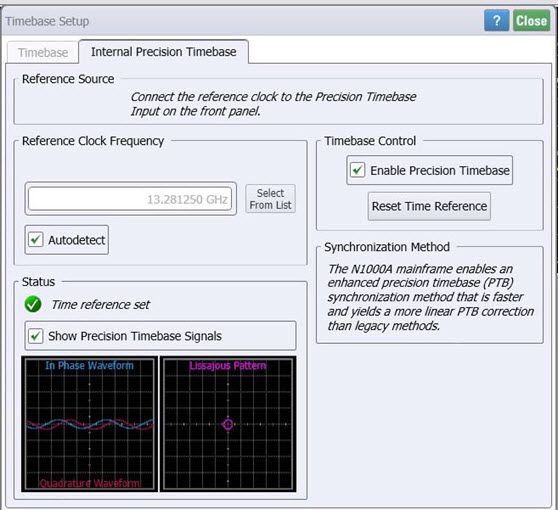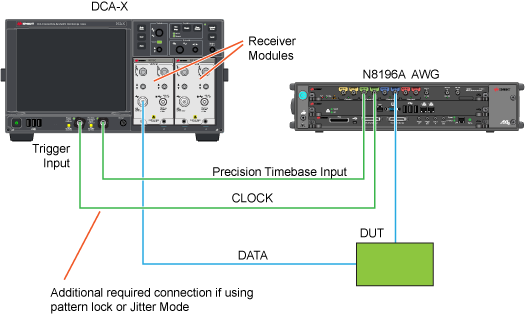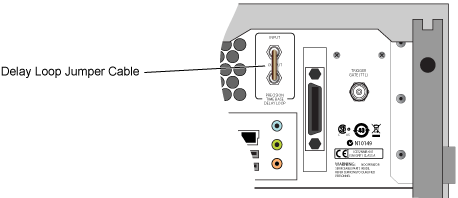PTB Tab
The Internal Precision Timebase tab is displayed on an N1000A-PTB instrument.

The Internal Precision Timebase ( N1000A-PTB) is disabled whenever an 86108A/B Precision Waveform Analyzer Module or 86107A Precision Timebase Module is installed.
Before entering the data in this dialog, make the required connections as shown in the following figure. When the precision timebase is used, the instrument does not normally use a trigger as the precision timebase creates its own internal trigger, and the reference clock is connected directly to the N1000A's front-panel Precision Timebase Input. You can also use the instrument in Free Run mode with this setup.
If pattern lock is turned on or Jitter Mode is used, connect the reference clock to both the front-panel Precision Timebase Input and to the front-panel Trigger Input. The Precision Timebase Input requires a full or sub-rate reference clock signal (square wave, BERT output, or a sine wave) from 2.4 to 44 GHz. If the edges of the clock are too fast for a reliable reference, you may need to add an external low-pass filter or additional cable length to soften the edges.
Figure. Setup for Optional Internal Precision Timebase

Avoid damaging the front-panel Precision Timebase Input. Do not use a reference clock greater than 1.3Vpp.
The following picture shows the rear-panel PRECISION TIME BASE DELAY LOOP jumper cable that is located on N1000A Option PTB instruments. This cable is meant for Keysight use only.
Removing the rear-panel PRECISION TIME BASE DELAY LOOP jumper cable disables the internal precision timebase.
Figure. Rear-Panel Location of Delay Loop Jumper Cable

Reference Clock Frequency Settings
Select the Reference Clock Frequency by clicking Select From List. This displays a list of standard optical and digital telecommunications rates. This list is also available in the Pattern Lock Setup tab of the Trigger dialog. FlexDCA determines the phase of a data sample within one period. The Precision Timebase Input requires a full or sub-rate reference clock signal (square wave, BERT output, or a sine wave) from 2.4 to 44 GHz.
If pattern lock is turned on, the Autodetect check box is displayed as shown in this picture. An Auto Scale automatically detects the external reference frequency. With pattern lock on, the instrument may be unable to correctly detect an external reference frequency. If this happens, clear the Autodetect check box.
PRBS data is not a suitable reference clock signal.
To ensure accuracy, the entered reference clock frequency must equal the actual external reference clock. Any deviations in either frequency will result in an inaccurate timebase. The instrument will display a warning message on the screen if the time reference is not valid. You must ensure that you connect a valid reference clock. If the precision timebase is on, you can perform an Auto Scale to reset the time reference.
Timebase Control Settings
 Select Enable Precision Timebase to enable or disable the precision timebase. The Precision Timebase button's green indicator
Select Enable Precision Timebase to enable or disable the precision timebase. The Precision Timebase button's green indicator  (on the button toolbar) indicates when the precision timebase is on. A yellow warning indicator
(on the button toolbar) indicates when the precision timebase is on. A yellow warning indicator  indicates that one of the following Internal Precision Timebase (IPT) conditions is true:
indicates that one of the following Internal Precision Timebase (IPT) conditions is true:
- IPT is not calibrated.
- Reference is not set.
- The signal is not connected to the N1000A's front panel connector.
If any changes in the reference clock occur, click Reset Time Reference to reset the precision timebase. The time reference will fail if:
- Reference clock signal is not:
- Valid frequency range
- Too large or too small
- DC offset > ±200 mV
- unstable frequency or amplitude
- A setup, in which the precision timebase was enabled when saved, is recalled
- Instrument power is turned on when the state of the precision timebase was enabled at instrument power off
Synchronization Method Settings

By default, precision timebase synchronization optimizes for RJ (Random Jitter) only. This provides a fast synchronization that is suitable for analysis of most signals. Optionally, you can choose to optimize both for RJ and for timebase linearity. This type of synchronization takes much longer but results in an extremely linear timebase as well as the lowest possible RJ. This type of synchronization is suggested for signals with extremely low DJ (Deterministic Jitter), where the signal rate is a multiple of the precision timebase reference frequency. For example, if your Symbol Rate is 32 GBd while your precision timebase reference frequency is 8 GHz, this option may improve the accuracy of the DJ measurements.
Status
The Status area of the dialog provides the following messages:
- Precision Timebase Off. The precision timebase is disabled. The time reference will be invalid until the precision timebase is enabled.
- No Time Reference. The precision timebase is enabled; however, the time reference is invalid. This status appears after changing the frequency band of the reference clock signal or recalling an instrument setup.
- Time Reference Set. The precision timebase is enabled and the time reference is valid.
- Time Reference Lost. The precision timebase is enabled. The instrument continues to acquire data using the most recent time reference. This status follows an absent reference clock signal, a clock signal that is too large (or too small), a clock signal that is not in a valid frequency band, or a clock signal that does not have a stable frequency.
Select the Show Precision Timebase Signals field to view the In Phase Waveform and Quadrature Waveform inputs to the precision timebase circuitry. Both an amplitude-vs-time chart and a Lissajous Pattern chart are displayed. This feature provides a qualitative view of the inputs. There is no remote command for making this selection. However, you can use the :WAVeform:SOURce command remote command to return the two waveforms.